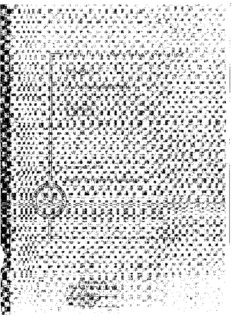Table Of ContentDISCLAIMER
This report was prepared as an account of work sponsored by an
agency of the United States Government. Neither the United States
Government nor any agency Thereof, nor any of their employees,
makes any warranty, express or implied, or assumes any legal
liability or responsibility for the accuracy, completeness, or
usefulness of any information, apparatus, product, or process
disclosed, or represents that its use would not infringe privately
owned rights. Reference herein to any specific commercial product,
process, or service by trade name, trademark, manufacturer, or
otherwise does not necessarily constitute or imply its endorsement,
recommendation, or favoring by the United States Government or any
agency thereof. The views and opinions of authors expressed herein
do not necessarily state or reflect those of the United States
Government or any agency thereof.
DISCLAIMER
Portions of this document may be illegible in
electronic image products. Images are produced
from the best available original document.
NXO-3071
ON ANGULAR MOAfENTUM
' 1. Introduction
One of the methods of treating a general angular mo-
mentum in quantum mechanics is to regard it-as the euper-
popition of a number of elementary "epins", or angular
molrenta w i t h 3 = 1/2. Such a spin assembly, considered as
a Rose-Einateln system, can he usefully discussed by the
method of second quantization. We shall see that this pro-
I
cedure unites the compact symbolism of the group theoretical
approach with the explicit operator techniques of quantum
mechanics
e
We introduce spin creation and annihilation operator8
associated w i t h a given spatial reference system,
+ +
ax+ = (a+,a_) and at = (a+,a-),. which aati-sfy
,
The number of spins and the resultant angular momentum m e
-
then given by
With the conventional matrix representation for p, the com-
-
ponents of J appear as
-
J+ = J1 + iJ2 = a++ a,, J, = ~1 iJ2 = a,+a + 9
.
Of course, this realization of the angular momentum commu-
tation properties i n terms of those of harmonic oscillators v
can be introduced without explicit reference t o 'the compos-
ition of spins,
To evaluate the square of the total angular momentum .
we employ the matrix elements of the spin permutation oper-
ator
Thus
I Y
and
According to the commutation relations (1,1), >
Whence
\
(leg)
I
- .
*' '
<I.
no-3071 P. 3
...
I . j = 81 n = 0, 81 , 1, (1.101
--
e?
We further note that, according to (1.3), a state w i t h
F a fixed number of positive,and negative spins also has a
definite magnetic quantum number,
-
m = -1(n n-) , (1.11)
2 +
Therefore, fmm the eigenvector of a state w i t h prescribed
.
r
occupation numbers,
1 ,
(1.12)
- we obtain the angular momentum eigenvector"
.: 1 5
P
-
Familiar as a symbolic expression of the transformation pro-
\
a++$ ,
perties of angular momentm eigenvectors this form is
here a precise operator construction of the eigenvector.
$
On multiplying (1.13) w i t h an analogous monomial con-
structed from the components of the arbitrary spinor
U
A direct proof is given i n Appendix A
*
See, f o r example, H. leyl, The Theory of %Groupsa nd
5 Quantum Mechanics (E. P., Dutton and Company, Inc.,
New Pork, 1931) p. 189
* ,
NYO -3 071 P. 4
we obtain, after summation with respect to m, and then with y
respect t o j,
.
(1.16)
ih which we have written
(1.17)
To illustrate the utility of (1.16), concieved of as an eigen-
vector generating function, we shall verify the orthogonalitg
.
and normalization of the eigenvectors (1.13) Consid.er, then,
& qo
According t o the comutation relations (l.l)#an d a = 0,
P
we have
(1.19)
I
NYO-3071 P. 5
\
(1.21)
As a second elementary example, we shall obtain the
-
1.
matrix elements of powers of J, - by considering the effect
-
of the operators elJ? on (le16). We have
,&I
and therefore
j'm'
which, on expansion, yields the non-vanishing matrix element
id-
s -
Similarly
&
Npo-3071
,
and
A particular consequence of (1.24) and (1.26) is
rbioh details the constfiction of an arbitrary eigenvector
from those possessing the maximum values of )ml compatible
with a given j.
It is &so possible to exhibit an operator which permits
the construction of an arbitrary eigenvector from that pos-
searing the minimum value of j compatible with a given m.
fisaeed, (1.131, written in the form
staters that
. "
mere K+, and two associated operators are defined by
,

